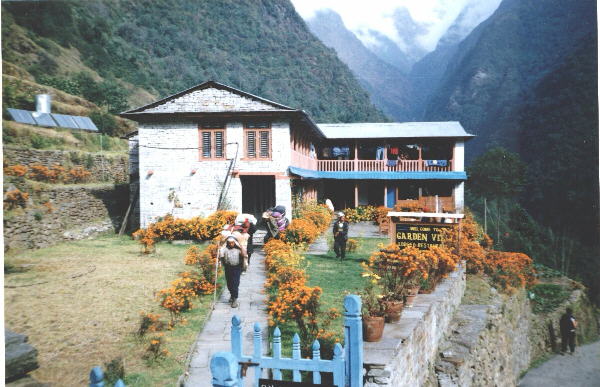

Annapurna - " Goddess Mother of the Harvests " - is, like Everest, a secluded peak. Although its 8000 metre summit may be glimpsed from Phewa Lake in Pokhara, protruding on the far horizon between the protecting bastions of Hiunchuli and Macchapuchre( the Fishtail Mountain ), a six-day trek over terraced hillsides strewn with picturesque villages and through the deep, dark gorge of the Modi Khola is required to reach the yak pastures and vast, glacier-filled amphitheatre ensconced at the foot of the world's tenth highest mountain.
 Base Camp beneath Annapurna I |
Named "the Sanctuary " by Colonel Jimmy Roberts, the pioneer and founder of organised trekking in the Nepal Himalaya, this was the site of the base camp of Chris ( now Sir ) Bonington on his successful assault on Annapurna's South Face.
The lodges along this popular route had mushroomed since my first visit ten years previously but thanks to the strict controls imposed by ACAP ( Annapurna Conservation Area Project ) the standards maintained are higher than other regions of Nepal and compare favourably with those of alpine huts in Europe. Inspectors check the general cleanliness of the lodges and their surroundings and also their foodstocks to ensure all items on the extensive menus are indeed available. The use of wood fires is banned and there is a depot for hiring stoves and the purchase of kerosene.
 Trekking lodge at Chomrong |
Altitude is the only difficulty in reaching the Sanctuary although no crossing of any high pass is required. On both my visits trekkers were encountered in distressed conditions from attempting to go too high too fast - one American was sure that if he pushed on the effects would wear off. Every year, despite widespread warnings, there are fatalities in the Nepal himalaya from AMS ( acute mountain sickness ).
The final two days above Chomrong, the highest permanent settlement in the area, are through dense, bamboo-and-rhododendron jungle lining the sheer-sided walls of the Modi Khola Gorge, with views ahead of the giant 7000 metre Gangapurna, before one emerges into the spectacular beauty of the Sanctuary.
|
Approach to the Annapurna Sanctuary |
October to December, the post-monsoon season, is the peak trekking period when the weather should be clear and dry but the walk-in on my return visit was in heavy, prolonged rainfall - it was the worst autumn weather in 25 years causing havoc with the still-to-be-harvested grain crops. The floor of the Sanctuary was covered in two feet of fresh snow while the Tharong La high pass on the Annapurna Circuit was temporarily blocked by the unseasonal snowfall forcing commercial trekking groups on fixed schedules to turn back and retrace their routes.
 |
In the afternoons mists tend to swirl up the valley but in the evening can clear, like a curtain being drawn, to expose the nearby Macchapucchre, the "Fishtail-mountain ", with its summit snowfields aflame in the sunset. An equally dramatic view can be obtained in the mornings when the great South Face of Annapurna I glows golden in the sunrise. Many trekkers miss out on these magic moments by staying at the lower Macchapuchre Base Camp and only making day-trips to the Sanctuary. They benefit however by avoiding the bone-biting, sub-zero, arctic temperatures which prevail in the ice-bound basin under star-spangled, himalayan night-skies.
Across the jumbled moraine of the South Annapurna Glacier a dangerous gully, bombarded by a constant fusillade of stonefall, emerges onto a level terrace and a 2000 foot climb gains the domed top ( c5000metres ) of Rakshi Peak - a snow summit not requiring a climbing permit. The ascent can usually be done in a single day from base camp but with its heavy cover of deep, soft snow I had to make a high camp and take two days ( possible thanks to my trekking crew ).
 Annapurna South Peak from Rakshi Peak |
The vantage point high in the centre of the Sanctuary provides a 360degree panorama of the encircling mountains and a proper perspective of their true immensity. Starting from Hiunchuli, the western sentinel above the narrow gateway to the Sanctuary, a tremendous ridge of ice and rock sweeps round the skyline encompassing the graceful Annapurna South Peak, the jagged, black pinnacle of Fang, and culminates in the formidable ramparts of Annapurna I. Nearby towers the aptly named Tent Peak ( nepalese name Tharpu Chuli - one of the so-called "trekking" peaks requiring a $200 climbing permit ) while the sacred and unclimbed Macchapuchre presents a shapely silhouette as the eastern sentinel above the gateway. The profound silence is violated on occasion by the reverberating roar of avalanches as huge blocks of snow and ice crash, amidst billowing clouds of spindrift, to the glacier far below.
 |
|
On the return journey to Pokhara a detour can be made from Chomrong through the major Gurung village of Gandrung, with its maze of narrow, paved alleyways and stone-built, slate-roofed houses surrounded by orange marigolds and superb outlooks on Annapurna South Peak, Hiunchuli and the twin tops of Macchapuchre ( maccha - fish, puchre - tail ).
( The Commentator, The (Glasgow) HERALD, Saturday 17th October 1998 )
Himalaya Map - Nelles ( UK , USA )
Nepal Trail Map - Nelles ( UK , USA )